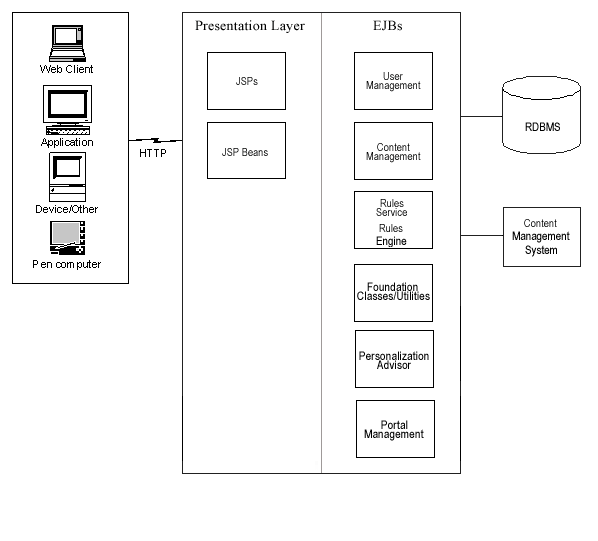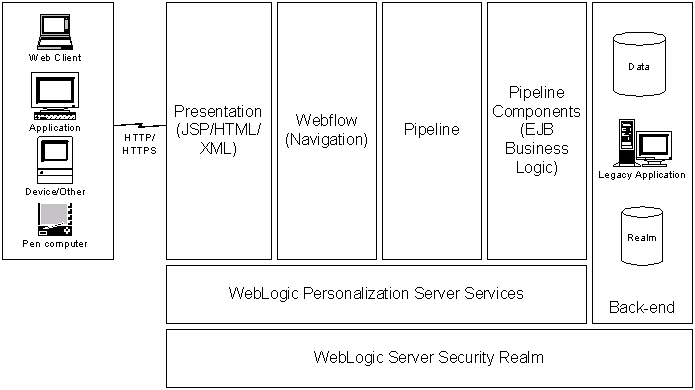


|

|
|
|
|
High-Level Architecture Model
This topic describes the high-level architecture model for the BEA WebLogic Commerce Server and Personalization Server with Portal Framework, and Campaign Manager. It includes system architecture diagrams and brief explanations for each server component.
This topic includes the following sections:
Personalization Server with Portal Framework Architecture
The BEA WebLogic Personalization Server product enables you to build, launch, and maintain high-performance Web sites that offer dynamic and personalized content delivery. Figure 2-1 illustrates the high-level architecture of the Personalization Server.
Figure 2-1 WebLogic Personalization Server Architecture
Web clients or other Web-based devices access the middle layer of the WebLogic Personalization Server through HTTP. This middle layer contains various components for both presentation (including JavaServer Pages) and business logic (specialized Enterprise JavaBeans). The EJBs use JDBC connections to communicate with a relational database. The Personalization Server uses a rules engine in concert with the user profile and content management system to determine personalized content for a user. Table 2-1 provides a brief description of each WebLogic Personalization Server component.
Commerce Server Architecture
The BEA WebLogic Commerce Server is an out-of-the-box product that allows you to quickly build and deploy e-commerce Web sites. The Commerce Server is shipped with the Personalization Server, which provides the mechanisms for personalization of this e-commerce functionality. Figure 2-2 illustrates the high-level architecture of the Commerce Server.
Figure 2-2 WebLogic Commerce Server Architecture
Web clients or other Web-based devices access the presentation layer of WebLogic Commerce Server via HTTP and HTTPS. The presentation layer handles the display of information using conventional technologies such as JSP, HTML, and XML. The Webflow layer handles all navigation logic. It also uses Pipeline components to access the EJB-based business logic that exists behind the Commerce APIs. Any of the layers within the Commerce Server system can make use of the personalization services provided by the WebLogic Personalization Server. Finally, the entire application leverages the WebLogic Server security services and WebLogic Server J2EE capabilities. Table 2-2 briefly describes each WebLogic Commerce Server component.
Campaign Manager
A campaign coordinates several WebLogic Personalization Server, WebLogic Commerce Server, and Campaign Manager for WebLogic services to create and track marketing goals on an e-commerce Web site. For example, an organization can use campaigns to sell 100 ACME saws during the month of June. To reach this goal, Marketing can target advertising, e-mail, and discounted product pricing to users who match a set of criteria, such as users who have previously purchased ACME hardware from a site.
Essentially, Campaign Manager is composed of a campaign service and a scenario service. There are two main Campaign Manager components: the Campaign Service on the server side, and the BEA E-Business Control CenterTM tools on the client, which are used to specify campaign scenarios.

|

|

|
|
|
|
Copyright © 2001 BEA Systems, Inc. All rights reserved.
|